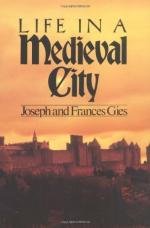
|
| Name: _________________________ | Period: ___________________ |
This test consists of 15 multiple choice questions and 5 short answer questions.
Multiple Choice Questions
1. Wealthy burghers can expect to have a home of how many stories?
(a) Two and a half.
(b) One.
(c) Four.
(d) They share a one-story home with another burgher.
2. Which of the following is an ideal quality of a wet nurse?
(a) The ability to play the lute.
(b) Intense powers of concentration.
(c) A strictly regimented diet.
(d) A thorough understanding of Latin and Greek.
3. What is a consignment?
(a) The process in which the church appoints a bishop to a particular town.
(b) A process in which wine is distilled.
(c) The property given over from the bride's family to the groom.
(d) The right to purchase all the wool for a particular person or organization.
4. What time period is covered by the book?
(a) From 250 BC to 800 AD.
(b) From the time of Socrates to the time of the American Revolution.
(c) From 800 AD to 900 AD.
(d) From Roman times to the middle of the 13th century.
5. Which of the following is NOT done in the counting room?
(a) Cooking.
(b) Accounting.
(c) Greeting of customers.
(d) Bookkeeping.
6. What kind of detergent is used for laundry time?
(a) Lard.
(b) Soap and ashes.
(c) Crushed rose petals and cream.
(d) Soap only.
7. In 1250, who lives in the Viscount's Tower?
(a) The Count of Champagne.
(b) Several merchant families.
(c) The Viscount.
(d) The Bishop of Troyes.
8. What might a dying man request as a form of penitence?
(a) To dip his coins and other property into a vat of boiling oil.
(b) To lie down on a hair cloth.
(c) To be set upon a raft made out of ebony wood.
(d) To drink the blood of an ox.
9. What is a typical mattress made of in 1250?
(a) Cotton.
(b) Goose feathers.
(c) Flour stuffed in sacks.
(d) Straw.
10. What does a midwife do?
(a) She buys food and other household items for the wife.
(b) She is a mistress for the burgher.
(c) She attends to a pregnant woman and aids her in the birthing process.
(d) She is reported to ward away evil spirits with her relics.
11. What is a garderobe?
(a) A garden pest that ruins vegetable patches.
(b) A toilet located next to the sleeping room.
(c) A fashionable high-collared dress.
(d) A high official in the Church.
12. Which of the following is a typical play activity for young children?
(a) Hunting.
(b) Bear baiting.
(c) Cock fighting.
(d) Recitation of epic poetry.
13. Why are Jews in a precarious position in Troyes?
(a) The Church actively hunts Jews in order to convert them.
(b) Royals may decree to ban Jews at any time.
(c) The Jews depend on the spice trade, which is sometimes interrupted.
(d) Their temples are constantly vandalized.
14. What accounts for varying degrees of quality in iron, as fashioned by a blacksmith?
(a) The quality of a blacksmith's hammer and anvil.
(b) Charcoal smelting that leaves copper in the metal.
(c) Charcoal smelting that leaves carbon in the metal.
(d) Ashes from the fire that leave carbon in the metal.
15. What is the difference between Jewish money lenders and Christian money lenders?
(a) Jews only lend foreign currency.
(b) Jews tend to lend at higher interest rates.
(c) Jews deal only in fenced (stolen) property.
(d) Jews tend to lend at lower interest rates.
Short Answer Questions
1. What does a fuller do?
2. What is Latin for "a place where people congregate inside walls?"
3. How many people share a wine cup during dining?
4. Which of the following is NOT an advantage of gold over iron?
5. How much time does an apprentice generally spend learning his craft?
|
This section contains 627 words (approx. 3 pages at 300 words per page) |

|




